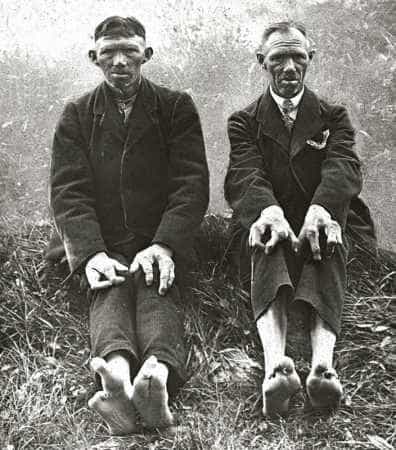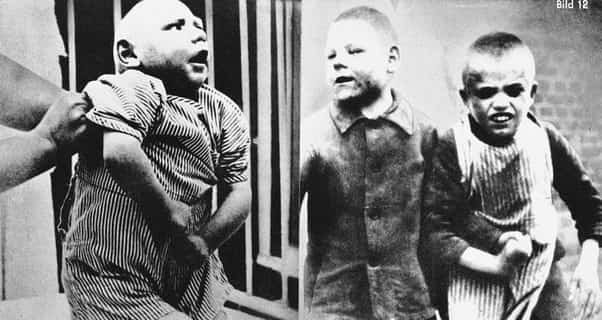Aktion T4: The Nazi Euthanasia Program

Systematic Killing of Disabled and Mentally Ill Individuals
The Nazi regime’s Aktion T4 program was a secret operation that resulted in the deaths of around 300,000 people.
These victims included individuals with disabilities or psychiatric illnesses. The name “T4” came from the program’s headquarters, located at Tiergartenstraße 4 in Berlin.
What Was Aktion T4?
Aktion T4 was the Nazi’s systematic murder of people they deemed “unfit to live.” This policy, implemented under the guise of “mercy killing,” was part of Nazi Germany’s larger eugenics program. The program aimed to purify the German race by eliminating individuals with disabilities or mental illnesses.
The seeds of Aktion T4 were planted as early as 1925 when Adolf Hitler wrote in *Mein Kampf* about his belief in Aryan racial superiority. After the Nazis came to power in 1933, they prioritized the “improvement” of the German race. Laws like the Nuremberg Race Laws banned marriages between Aryans and non-Aryans, while programs like “Lebensborn” encouraged the birth of Aryan children. Aktion T4 became one of the most horrifying extensions of these racist ideologies.
Who Was Responsible for Aktion T4?
The program began in October 1939, following direct orders from Adolf Hitler. Key figures in its operation included:
- Philipp Bouhler: A senior Nazi official and the head of Hitler’s Chancellery. Bouhler oversaw Aktion T4 and the killing of over 250,000 disabled individuals. He also played a role in Aktion 14f13, which murdered thousands of concentration camp prisoners.
- Karl Brandt: Hitler’s personal physician and one of the program’s main organizers. Brandt was later appointed Reich Commissioner for Sanitation and Health. Convicted of war crimes, he was executed in 1948.
- Viktor Brack: Head of Hauptamt II (Main Office II) and a crucial figure in planning and implementing Aktion T4. He was also responsible for organizing mass killings in concentration camps. Like Brandt, Brack was executed in 1948.
These men led a network of officials, doctors, and nurses who carried out the program’s horrifying objectives.
The Goals of Aktion T4
The primary aim of Aktion T4 was to maintain the “genetic purity” of the German people. The Nazis claimed that individuals with disabilities or mental illnesses lived “meaningless lives” and endured “unnecessary suffering.” In reality, the program was a cold, calculated effort to rid society of those they deemed unworthy.
Economic considerations also played a role. By eliminating disabled individuals, the Nazis argued that healthcare workers could focus on supporting the war effort instead. Propaganda further supported the program by spreading fears of an increase in mental illness within the population, urging swift action.
How the Killings Were Carried Out
The victims of Aktion T4 were transported to designated euthanasia centers under false pretenses. Families were often told their loved ones were being moved to better facilities. In reality, these individuals were taken to centers where they were systematically murdered.
- Methods of Execution: Victims were killed using gas chambers, lethal injections, poison, starvation, or drug overdoses.
- Role of Medical Personnel: Doctors and nurses, trusted to care for patients, actively participated in these killings. They performed fake medical evaluations and led victims to their deaths under the pretense of medical treatment.
The Nazis meticulously concealed the program, using unmarked vehicles and keeping the true purpose of the transports secret. Upon arrival at the euthanasia centers, victims were assessed before being sent to gas chambers.
Scale of the Murders
Initial estimates suggested that around 70,000 people were killed during Aktion T4. However, recent research indicates the number of victims in Germany and Austria alone was closer to 200,000, with another 100,000 killed in other European countries.
In Poland, the killings were carried out with brutal efficiency, often using gas vans, bunkers, and mass shootings. Unlike in Germany, Polish families were rarely informed about the fate of their loved ones, and emptied psychiatric wards were handed over to the SS.
The Victims of Aktion T4
The victims were diverse but shared the common trait of being labeled “undesirable” by the Nazi regime. They included:
- People with schizophrenia, epilepsy, dementia, or other chronic mental or neurological conditions.
- Individuals with physical disabilities, including blindness, deafness, and paralysis.
- Children considered “mentally defective.”

This tragic chapter in history serves as a reminder of the dangers of intolerance and discrimination. Honoring the memory of these victims is essential to preventing such atrocities in the future.
Public Resistance and Continued Killings
The Catholic Church, led by figures like Cardinal Clemens August von Galen, voiced strong opposition to Aktion T4. Under growing pressure, Hitler officially halted the program on August 18, 1941. By then, over 70,000 people had already been killed.
Despite the official suspension, the killings continued in secret. Doctors and nurses in Germany, Austria, and Poland carried out murders in ways that minimized public suspicion. However, in occupied territories, the killings were often more brutal and visible.
Many individuals involved in Aktion T4 later contributed to the Holocaust. They helped develop gas chambers used in extermination camps like Treblinka, Sobibór, and Bełżec, furthering the Nazis’ genocidal goals.
Notable Victims: Aloisia Veit
One of the victims of Aktion T4 was Aloisia Veit, Adolf Hitler’s grandniece. Veit, who had schizophrenia, was murdered in December 1940 at the age of 49. Her inclusion in the program likely stemmed from rumors about mental illness in Hitler’s family. It is unclear if Hitler knew of her death, though he had approved the program.
Aftermath: Justice and Memorials
After World War II, many of those responsible for Aktion T4 faced justice, but others escaped prosecution. In 1961, a West German court convicted 16 individuals for their roles in the program. Still, many perpetrators avoided accountability.
In 2013, a memorial was erected at Tiergartenstraße 4 in Berlin to honor the 200,000 to 300,000 victims of Aktion T4. The monument serves as a stark reminder of the horrors of discrimination and the importance of safeguarding human rights.
The Lasting Impact of Aktion T4
Aktion T4 claimed the lives of an estimated 300,000 people. By the end of 1941, a third of Germany’s mental institution residents were dead. The program left a lasting scar on humanity, highlighting the dangers of unchecked prejudice and authoritarian rule. Remembering these victims is crucial to building a future rooted in empathy, dignity, and respect for all.
FAQ: Aktion T4 – Nazi Euthanasia Program
1. What was Aktion T4?
Aktion T4 was a Nazi program during World War II aimed at the systematic murder of people with disabilities or psychiatric illnesses. It was part of the regime’s eugenics agenda to preserve the so-called genetic purity of the Aryan race.
2. Why was it called T4?
The program was named after the address of its headquarters in Berlin: Tiergartenstraße 4.
3. Who were the main individuals responsible for Aktion T4?
Key figures included:
- Philipp Bouhler: Head of the program and a senior Nazi official.
Karl Brandt: Hitler’s personal physician and organizer of Aktion T4. - Viktor Brack: Oversaw the program’s implementation and operations.
4. When did Aktion T4 begin?
The program officially started in October 1939, following orders from Adolf Hitler.
5. What was the objective of Aktion T4?
The goal was to eliminate individuals considered “unworthy of life” due to disabilities or mental illnesses. The Nazis believed this would reduce the burden on society and align with their racial purity ideals.
6. How were the victims selected and transported?
Victims were often taken from homes or institutions under false pretenses. Many were told they were being transferred to better facilities or medical centers. Transportation was carried out secretly, using unmarked vehicles.
7. How were the killings carried out?
The killings were executed through methods such as:
- Carbon monoxide poisoning in gas chambers
- Lethal injections
- Starvation and neglect
8. How many people were killed in the Aktion T4 program?
Approximately 200,000 to 300,000 people, including children, were murdered as part of this program.
9. Did Aktion T4 stop in 1941?
Although officially halted in 1941 due to public resistance, including pressure from the Catholic Church, the killings continued in secrecy.
10. Were any of the perpetrators held accountable after the war?
Some individuals involved in Aktion T4 faced trials after World War II, such as Karl Brandt and Viktor Brack, who were executed for war crimes. However, many escaped justice.
11. How is Aktion T4 remembered today?
A memorial was established in Berlin at Tiergartenstraße to honor the victims. It serves as a reminder of the atrocities committed and the importance of combating discrimination and prejudice.
